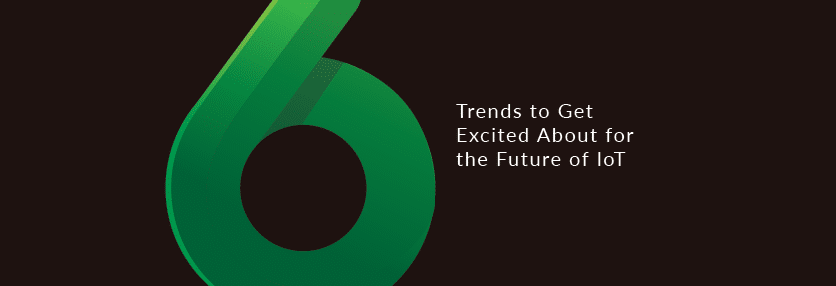6 Trends to Get Excited About for the Future of IoT
Smart and autonomous, interconnected, and self-managed – the Internet of Things (IoT) continues to grow in complexity and intelligence. Connected devices should simplify everyday life, provide industrial security, and protect the environment. Technology trends should make a difference for every customer, citizen, and manufacturer. Let’s find out what the future trends will look like for IoT.
Having analyzed reputable sources and professional observations, we’ve singled out 6 growing trends for the future of IoT. Among the top predictions, all the researchers emphasize growing volumes of the Internet of Things as a phenomenon. The future of IoT looks promising, and the facts speak for themselves:
- Gartner believes, that the number of IoT devices installed worldwide will hit 20 billion by the year 2020.
- A study by General Electrics and Accenture estimates that IoT can add $15 trillion to the worldwide GDP growth.
- Business Insider predicts that by 2021, business spendings on IoT solutions will reach $6 trillion.
Fascinating, isn’t it? Now, let’s have a closer look at the IoT trends booming today.
Stay Alert and Connected: IoT Continues Its Expansion

Entreprises, tech leaders and development companies are currently working to flesh out the actual applications of IoT techniques.
An increased need for business value and outcomes will lead to the increased number of sensors embedded into the newly produced digital products. More industries will look at IoT as a magic wand to attract customers, develop brands and improve the user experience. Gartner is of the same opinion and declares that by 2020, 95% of electronics will be IoT-enabled. Manufacturers are expected not only to expand the number of IoT devices but to make them more available and comprehensive.
Security – a Mounting Concern that Clouds the Future of IoT

Data protection will be the most welcome security trend in the future as IoT growth continues to outpace its security options. Having a device that is connected to the Internet is both liberating and dangerous. Using spyware, violators can track your online activity, private information can easily be made public and personal data is too often sold for marketing and other malicious purposes.
Smart home infrastructure, wearable devices and autonomous vehicles are among top targets for vicious hackers and robbers, making them vulnerable to breaches and violations. While unfortunate for those who are targeted, it’s also a treasure trove for IoT startups that can address this challenge. And the blockchain technology can be one of the possible cures to the security issues in IoT.
Blockchain as a Sheet Anchor for the IoT Concerns
Although we generally associate blockchain technology with cryptocurrencies, blockchain is among the main trends in the future of IoT.
- A multitude of real-world objects connected by IoT can be effectively managed, tracked and coordinated by blockchain. It leads to a more flexible environment for IoT devices to run in.
- Connected IoT devices can use blockchains to organize, store and share streams of data reliably. Even if there are different networks and device sets, blockchain records allow anyone with appropriate authorization to connect and take necessary actions.
- Blockchain cryptographic algorithms are a secure shield protecting consumers’ data and are one of the most robust encryption standards currently available.
A Pressing Need to Process IoT data – AI to the Rescue

With the expansion of IoT, the amount of data will only increase. To make sense of this data avalanche, businesses need to find an ideal way to gather, store and process all of it. The solution is Artificial intelligence (AI). The future of AI is closely connected with the future of IoT.
Data analytics tools, powered by AI and machine learning algorithms will be more in demand. These tools will be in charge of tasks and operations, where humans with their limited capacities simply fail to perform. Advanced AI software needs to provide real-time data streaming for IoT devices, help businesses extract meaningful insights and predict the most profitable outcomes.
A Shift in Voice Control: From Mobile Platforms to Managing IoT Ecosystems

Apple’s Siri, Google Assistant, Amazon’s Alexa and Microsoft’s Cortana voice assistants are already well-known to smart home users. Voice technologies will strengthen their influence on the future of AI and IoT. The reason is their comparative ease-of-use, which leads to the potential widespread adoption.
The positive market response is one of the factors that makes voice control the primary user interface for managing IoT devices. Major tech players are competing to integrate voice-activated assistants into a bigger number of connected devices: refrigerators, cars, TV sets, wearables, home robots and more. Amazon’s Alexa seems to be ahead of its rivals with greater integration into a range of third-party apps. But Google doesn’t trail far behind. Have a look at a recent campaign advertising for Google Assistant, which has now become compatible with more smart devices and services.
Despite Existing Challenges, Smart Cities will Thrive on IoT Technologies

The future of IoT holds significant advancements for the concept of “smart cities”. Moving out of smart homes, the IoT approach increases the quality of life, improves operations and improves services rendered to citizens. Even though this growing IoT trend should overcome challenges on its way, it also may serve as the cure to most urban ills. Government, society and technology providers should work together with different stakeholders, attract investments and fight inequality that less qualified and educated inhabitants might experience.
The smart cities concept is gathering steam all over the world. This IoT trend is in demand in the UK, the UAE, Spain, Germany, the US and Singapore. In Los Angeles, the LA Express Park makes use of sensors and mobiles apps, while also providing 40,000 smart parking meters. StreetLine, the startup behind the smart park, claims 3 million miles of driving time spared for the users.
Conclusion
That’s certainly not a complete list of trends shaping the future of IoT. But these inspirational tendencies shed the light on the possible benefits businesses can look forward to with wider adoption of IoT.
Current IoT trends make us believe that homes and cities can be safe, friendly to the environment and smart. They transform customer experiences to make life more fascinating and somehow simpler. Tomorrow’s washing machines, for example, may be smart enough to handle the laundry themselves by scanning clothing labels for proper wash settings. It sounds like science fiction, but it’s more realistic than we think.

